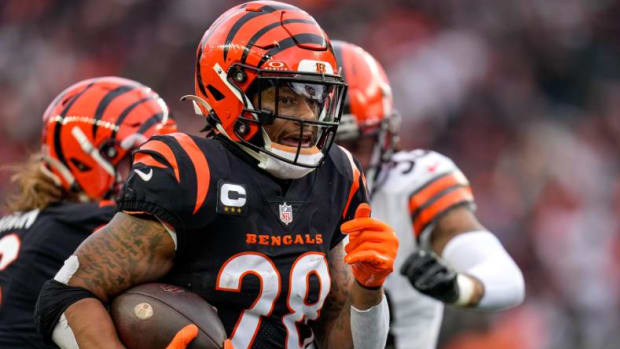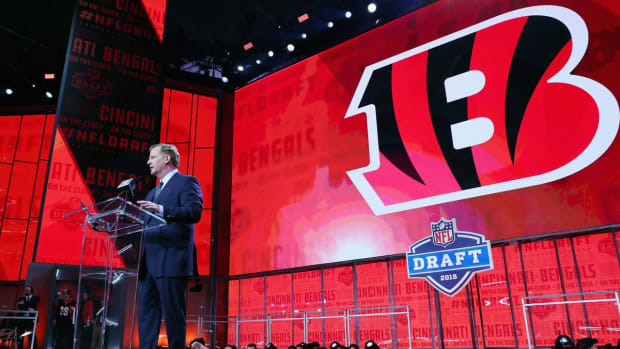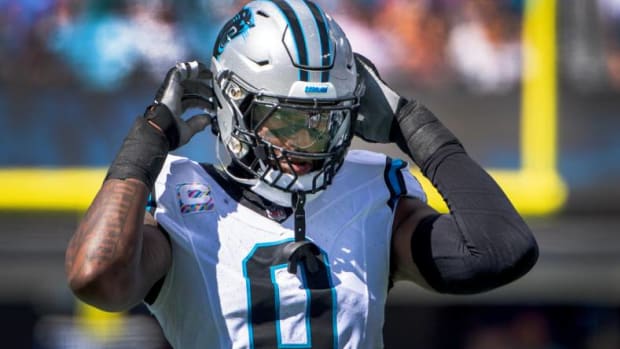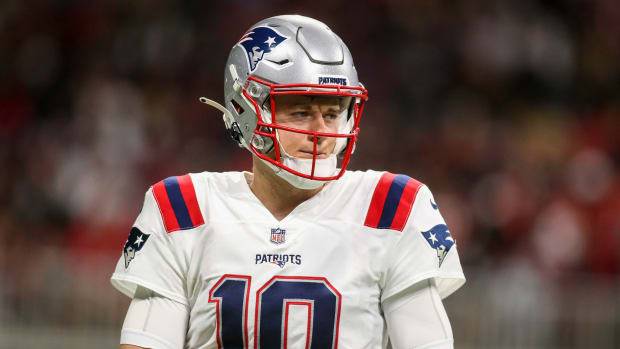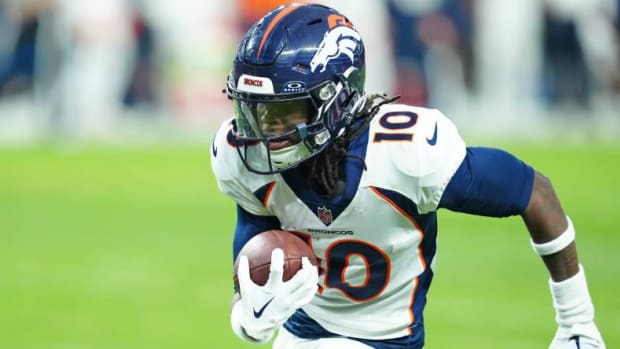NFL Draft: Running Back Projections For 2023 NFL Draft
In 1994 NFL Commissioner Paul Tagliabue walked across the Marriott Marquis stage in New York City to announce the commencement of the NFL Draft. Ohio State’s defensive tackle Dan Wilkinson was the top choice overall, and Mr. Irrelevant Marty Moore capped off the event as the final pick amongst the 222 chosen.
It also marked the first time the draft was condensed down to its current format of seven rounds. That also coincides with where our journey begins. Looking back over the last 29 years, we have seen the draft pivot from how picks are valued to what position has lost value.
Last year the first round was inundated with day-one trades. A record-setting nine trades emerged on day one of the 2022 NFL Draft. Trades are going up and running backs drafted are going down. For the third time since 2013, zero running backs were selected before the second round. The current landscape of the National Football League numbs us to the notion this is how it’s always been done, but that is far from the truth.
“I think basically the era we are presently in is being dominated by the passing offense,” Miami Hurricanes general manager of football operations Alonzo Highsmith said. “The running back isn’t a premium position. You can win without elite running backs in today’s NFL.”
Highsmith, a Hurricanes legend from 1983-86, was the third overall pick in the 1987 NFL Draft. His generation of authoritative big, bodied power backs governing the first round of the NFL Draft was about to begin its demise. Another decade later, Highsmith would have been with the NFL emerging offensively in another direction. The talented Highsmith, like most elite running backs leaving college, would have found themselves being marginalized in value.
Over the last ten seasons, we have witnessed three first rounds (2013, 2014 and 2022) end with no running backs drafted. The AFL-NFL merger agreement was done in June of 1966. One year later, in 1967, the first draft with both leagues was united in selecting players. The bidding wars would cease as the two leagues combined. A span that stretched over 45 years between 1967 to 2012 had at least one running back selected in the first round.
The 94’ NFL Draft had Hall of Fame running back Marshall Faulk drafted second overall by the Indianapolis Colts. Greg Hill was the only other tailback taken in that first round, going 25th overall to the Kansas City Chiefs. It also marked the last time a fullback would be selected in round one. The San Francisco 49ers used the 28th overall pick on Florida State’s Williams Floyd.
Let that sink in.
The 49ers used their first-round pick on a fullback.
Imagine the 49ers using a first-round pick on their seven-time Pro Bowl fullback Kyle Juszczyk. Despite his immense importance to the team, it is unthinkable to project him as a first-round selection. Juszczyk was taken in the fourth round of the 2013 NFL Draft. Faulk’s second overall selection was topped one year later when Penn State’s Ki-Jana Carter went No. 1 to the Cincinnati Bengals. Since 1994, there have been three other backs taken second overall, with Saquon Barkley being the most recent in 2018, and Carter might become cemented in NFL history as the last running back drafted No. 1 overall.
Twelve running backs have gone in the first round since 2014, compared with the 58 selected in the previous twenty years, once again demonstrating the catastrophic collapse of the position in comparison with the top-tier prospects available.
RBs Drafted in First Round
1994-2003: 31
2004-2013: 27
2014-2022: 12
The first round of the draft has shown the most dramatic change. There are, on average, 3.4 fewer running backs drafted in all seven rounds over the last nine years compared to 1994-2003, and the chart below shows the consistent dip.
Average RBs Drafted Every 10 Years
1994-2003: 25.9 Drafted Annually
2004-2013: 23.5 Draft Annually
2014-2022: 22.5 Drafted Annually
Collectively, the position of running back has lost most of its luster on days one and two of the NFL Draft. The current three-day format provides the bulk of the position finding homes on the final day of selection. The middle rounds have seen higher numbers of running backs selected, but their overall drafted totals at the position remain in decline. With rounds four, six and seven going over the century mark in picks combined, it’s easy to identify where teams gauge their value.
Total RBs Drafted by Rounds
Year: Round 1 | 2 | 3 | 4 | 5 | 6 | 7 | Total
1994-2003: 31 29 45 45 29 39 41 259
2003-2013: 27 29 21 34 29 41 49 230
2014-2022: 12 22 28 42 27 38 34 203
29 years: 70 80 94 121 85 118 124 692
Texas running back Bijan Robinson is the only sure-fire running back being considered worthy of a first-round pick in Kansas City for the 2023 NFL Draft. Alabama’s Jahmyr Gibbs is an outlier of first-round temptation for NFL evaluators. Robinson is viewed as one of the most elite prospects in the draft, but the NFL’s current path toward success strips him of his stand-alone value.
“To be dominant a running back requires special traits that few have,” Highsmith said regarding their status in NFL Draft evaluation circles.
In 1994, Robinson would be hovering near the status of Faulk, being selected second overall. Now, Robinson would pinch himself if he woke up in a dream of hearing his name called amongst the top ten. It’s the sign of the times that we’ve grown accustomed to. Robinson is an elite prospect devalued due to the position he plays.
So, the next young group of talented ball carriers will likely begin to hear their names come off the draft board on Friday night when rounds two and three commence. Their destination differs from previous generations when running backs were drafted to be the workhorse and backbone of every offense. A third-down framed pass catcher out of the backfield carries more weight in today’s league.
2023 NFL Draft Round Predictions for Running Backs
Round 1 Bijan Robinson, Texas
Round 2 Jahmyr Gibbs, Alabama
Round 3 Zach Charbonnet, UCLA, Zach Evans, Mississippi, Devon Achane, Texas A&M,
Round 4 Tyjae Spears, Tulane, Israel Abanikanda, Pittsburgh
Round 5 Sean Tucker, Syracuse. Eric Gray, Oklahoma. Mohamed Ibrahim, Minnesota. DeWayne McBride, UAB. Roschon Johnson, Texas. Tank Bigsby, Auburn
Round 6 Kenny McIntosh, Georgia. Kendre Miller, TCU. Chris Rodriguez, Kentucky. Evan Hull, Northwestern
Round 7 Chase Brown, Illinois. Deuce Vaughn, Kansas State. Cam Peoples, App State. Keaton Mitchell, East Carolina
Twenty-one running backs are listed above. That is 1.5 below the average over the last decade of 22.5 average. Arguing their specific value once the draft commences is anyone’s guess. The debate on how many will get selected is another discussion that none of us will know until the draft concludes. The NFL Draft has brought running backs to their lowest production in terms of selection since the AFL/NFL merger.
Have we reached the bottom?
Another ten years from now, when most of the rookies listed above are no longer in the league, we will know one way or the other if the running back position continued to be diminished or showed a rebirth.
Which way are you leaning?
With dynasty fantasy football rookie drafts coming up, running backs are going to be a hot commodity. Faceoff Sports Network has your dynasty fantasy football links to keep you one step ahead of your league.
